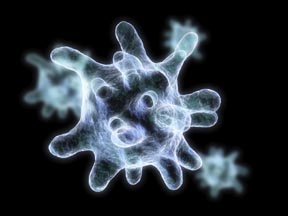A new class of drugs completing clinical trials soon for rheumatoid arthritis should be examined as a treatment for multiple sclerosis, according to the authors of a University of Alabama at Birmingham study published today in the Proceedings of the National Academy of Sciences.
 |
| Overactive immune cells called macrophages strip away nerve cell coatings as part of MS. |
The UAB study focused on a protein called “suppressor of cytokine signaling 3,” found in low levels among MS patients in relapse. With less SOCS3 to restrain it, rising levels of the protein STAT3 cause immune cells to release chemicals that strip the myelin coating from the brain’s nerve cells, which makes them less able to pass messages and causes symptoms from numbness to paralysis.
In a mouse model genetically engineered with low SOCS3 and high STAT3, a condition called experimental autoimmune encephalomyelitis (EAE), the mouse equivalent of MS, quickly developed. However, the research team reported that restored SOC3-signaling lowered STAT3 levels and reversed the disease.
The findings are timely because STATs (Signal Transducers and Activators of Transcription) are part of the JAK-STAT pathway targeted by a new class of JAK inhibitors, the first of which are expected to finish clinical trials for the treatment of rheumatoid arthritis and seek regulatory approval this year. Such drugs should be considered for the treatment of MS, say the authors, who already are conducting pre-clinical studies.
“We already are working to see whether JAK-STAT inhibitors reverse MS-like disease in mice,” said Hongwei Qin, Ph.D., associate professor of UAB Department of Cell, Developmental, and Integrative Biology, and first author on the study. “Our wish is to contribute to the design of a new class of drugs against autoimmune diseases and other diseases, given that inflammation is a hallmark of many cancers, Parkinson’s and Alzheimer’s disease as well as MS.”
STAT3-signaling is known to activate microglia and monocytes, the immune cells of the brain and macrophage scavengers that collect and dispose of damaged tissue or invading bacteria. They can promote either injury or repair in the central nervous system, depending on the signals they get.
Autoimmune diseases such as rheumatoid arthritis and MS develop when immune cells, which have evolved to attack invaders such as bacteria, mistakenly target the body’s own cells. Past studies show the wounds seen on the nerve cells of MS patients worsen when these immune defenses go awry and the number of activated macrophages rises.
STAT3 also triggers another set of immune cells — helper T cells — to differentiate into its inflammatory versions, which better infiltrate the brain from the blood stream. Those activated T cells produce chemicals that send macrophages down the pathway toward inflammatory activation, completing a vicious circle.
For additional confirmation, researchers gave mice lacking the SOCS3 gene the kind of anti-inflammatory macrophages that SOCS3 would have signaled to create. Those mice generated fewer immune-activating macrophages, lower STAT3 levels and fewer helper T cells trumpeting for a full-scale immune response. The result was less severe and slower advancing EAE.
“Our results argue that the JAK-STAT pathway plays a central role in the inflammatory damage done to nerve cells in MS, which is exciting especially because new drugs that counter this pathway already have proven safe in humans,” said Etty (Tika) Benveniste, Ph.D., chair of the Department of Cell, Developmental and Integrative Biology and senior author for the study. “Beyond JAK-STAT inhibitors, our new understanding may aid in the design of other drug classes that directly inhibit STATS or replace missing SOCS3.”
Excitement surrounds the JAK-STAT pathway because without it some 60 cytokines cannot pass on messages that regulate the immune system. When a cytokine-signaling protein docks into its receptor on the surface of an immune cell — like a ship coming into port — the receptor changes shape to turn on Janus kinase (JAK) inside the cell, which helps to activate STATS. STATS then travel to the cell’s nucleus, link to DNA and turn on genes that amplify the immune response. Evidence suggests the new drugs that act on JAKs — and through them STATs — roll back this response more broadly and gently than drugs targeting single cytokines, with fewer side-effects and less chance of suppressing the immune response too much.
“Some research argues that STAT-inhibition may be better than JAK-inhibition in cancer biology because pathways other than JAKs activate STAT-transcription factors,” Benveniste said. “If several pathways activate the STATs, why not inhibit them directly to cover all bases? Gene-knockdown studies already have shown that tumors shrink in mice without the STAT3 gene.”
Also making important contributions to the study within the Benveniste lab were Yudong Liu, Michelle Muldowney, Thomas Fox III, Keun Park, Ph.D., Stephanie Reynolds, Andrew Holdbrooks and Lora Yanagisawa, Ph.D.
Patrizia De Sarno, Ph.D., assistant professor in the Department of Psychiatry and Behavioral Neurobiology; Chander Raman, Ph.D., professor in the Department of Medicine; Laurie Harrington, Ph.D., assistant professor in the Department of Cell, Developmental and Integrative Biology; and graduate student Wen-I Yeh contributed to the effort.
